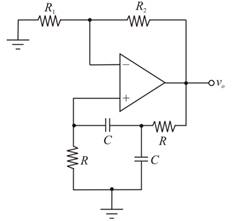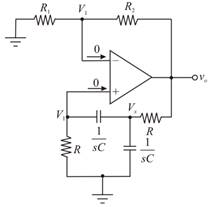
Concept explainers
The loop gain, the frequency of the oscillation and the required ratio of the resistance to obtain the oscillation for the given function.
Answer to Problem 15.40P
Explanation of Solution
Given:
The circuit is given as:

For the ideal operation amplifier, the inverting and non-inverting terminal currents should be 0. The inverting and non inverting node voltages should be equal by the virtual ground concept.
Redrawing the above circuit:

Applying Kirchhoff s current law at node
Hence,
Applying Kirchhoff s current law at non-inverting node:
Substituting
Therefore, the feed-back gain is given as:
Applying Kirchhoff s current law at inverting node:
Therefore,
The loop gain is known as the multiplication of the amplifier gain and the feedback transfer function gain as shown below:
Therefore,
The transfer function is
Put
Therefore,
For frequency oscillation the real part should be 0:
Therefore,
The frequency oscillation is
For the oscillation, the imaginary part is equal to 1:
Therefore,
Want to see more full solutions like this?
Chapter 15 Solutions
MICROELECT. CIRCUIT ANALYSIS&DESIGN (LL)
- 4. Discussion: Compare between theoretical effect of KD at first order and second order systems regarding steady-state errors and transient responses with the practical obtained results whenever applying step input signal. In Experiment Derivative Controller 55-82arrow_forwardFor the state space model, find the following: 1. Identify the state-space matrices A,B,C, and D. 2. Compute the transfer function G(s) analytically (by hand). 3. Solve for x(t) given a step input u(t) =1 and zero initial conditions (use transition matrix). 4. Use MATLAB to compute the transfer function. 5. Plot the step response using MATLAB. [X] = 71+0u y = x1 + x2 -2 นarrow_forwardA DPSK has the following data input: d(n) =101011010001 1. Find the output coded sequence and the carrier phase. 2. Recover the input data from the output coded sequence.arrow_forward
- Q9 A single-phase transformer, 2500 / 250 V, 50 kVA, 50 Hz has the following parameters, the Primary and secondary resistances are 0.8 ohm and 0.012 ohm respectively, the primary and secondary reactance are 4 ohm and 0.04 ohm respectively and the transformer gives 96% maximum efficiency at 75% full-load. The magnetizing component of-load current is 1.2 A on 2500 V side. 1- Draw the equivalent circuit referred to primary (H.V side) and inserts all the values in it 2- Find out Ammeter, voltmeter and wattmeter readings on open-circuit and short-circuit test. If supply is given to 2500 V side in both cases. Ans. O.C. Test (Vo= 2500 V, lo=1.24 A, Wo=781.25 w) S.C. Test (Vsc =164.924 V, Isc =20 A, Wsc =800 w )arrow_forwardA modulating signal f(t) is bandlimited to 5.5 kHz is sampled at a rate of 15000 samples/sec. The samples are quantized into 1024 levels. Calculate transmission bandwidth if the following modulation types are used for signal transmission: 1-ASK, QAM 2-QPSK, 8-PSK 3-FSK, 8-FSK with Af = 20 kHzarrow_forwardQ10 The full-load copper loss on the H.V. side of 100KVA, 11000/317 V, single-phase transformer is 0.62 kw and on the L.V. side is 0.48 kW. i) Calculate R1, R2 in ohms ii) Find X1,X2,if the percentage equivalent reactance is 4%, and reactance is divided in same proportion as resistance. Ans, 27.30, 0.175), 0.00482 . (7.5)arrow_forward
- Find the binary sequence, for the following Differential Manchester code.arrow_forwardQ2- What are the parameters and loss that can be determined during open-circuit test of singlephase transformer. Draw the circuit diagram of open-circuit test and explain how can you calculate the Parameters and loss.arrow_forwardQ6- the open circuit and short circuit tests on a 10 KVA, 125/250 v, 50 Hz single phase transformer gave the following results: O.C. Test: 125 V,0.6 A, 50 W ( on L.V.) S.C. Test: 20 V, 40 A, 177.78 W (on H.V. side) Calculate: i) Copper losses on half load ii) Full load efficiency at 0.8 leading p.f. iii) Half load efficiency at 0.8 leading p.f. iv) Regulation at full load at 0.9 leading p.f. Ans: 44.445 W, 97.23%, 97.69%, -1.8015%arrow_forward
- Q3-A two-winding transformer has a primary winding with 208 turns and a secondary winding with 6 turns. The primary winding is connected to a 4160V system. What is the secondary voltage at no load? What is the current in the primary winding with a 50-amp load connected to the secondary winding? What is the apparent power flowing in the primary and secondary circuits? Ans. 120 V, 1.44 A, 6000 VAarrow_forwardQ12- A three phase transformer 3300/400 V,has D/Y connected and working on 50Hz. The line current on the primary side is 12A and secondary has a balanced load at 0.8 lagging p.f. Determine the i) Secondary phase voltage ii) Line current iii) Output power Ans. (230.95 V, 99.11 A, 54.94 kW)arrow_forwardQ1- A single phase transformer consumes 2 A on no load at p.f. 0.208 lagging. The turns ratio is 2/1 (step down). If the loads on the secondary is 25 A at a p.f. 0.866 lagging. Find the primary current and power factor.arrow_forward
 Electricity for Refrigeration, Heating, and Air C...Mechanical EngineeringISBN:9781337399128Author:Russell E. SmithPublisher:Cengage Learning
Electricity for Refrigeration, Heating, and Air C...Mechanical EngineeringISBN:9781337399128Author:Russell E. SmithPublisher:Cengage Learning
